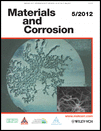
MATERIALS AND CORROSION-WERKSTOFFE UND KORROSION
Scope & Guideline
Unveiling the Secrets of Material Durability
Introduction
Aims and Scopes
- Corrosion Mechanisms and Phenomena:
Research on the underlying mechanisms of corrosion processes, including electrochemical reactions, environmental influences, and material properties that affect corrosion behavior. - Material Performance and Testing:
Studies evaluating the performance of various materials (metals, alloys, coatings) under different corrosive environments, using experimental and simulation methods. - Corrosion Protection Strategies:
Development and assessment of innovative corrosion protection techniques, including coatings, inhibitors, and cathodic protection methods. - Environmental Impact Assessments:
Research focusing on the environmental factors that influence corrosion, such as temperature, humidity, and chemical exposure, particularly in extreme conditions. - Sustainable Materials and Green Chemistry:
Exploration of eco-friendly corrosion inhibitors and sustainable practices in material selection and corrosion management.
Trending and Emerging
- Advanced Coatings and Surface Treatments:
There is a significant increase in research focused on novel coatings and surface modifications that enhance corrosion resistance, including nanocomposite and superhydrophobic coatings. - Microbiologically Influenced Corrosion (MIC):
Research on microbiologically influenced corrosion is gaining momentum, emphasizing the role of bacteria in corrosion processes and the development of bio-inspired mitigation strategies. - High-Entropy Alloys and New Material Classes:
The exploration of high-entropy alloys and other novel material classes is trending, driven by their unique properties and potential applications in corrosive environments. - Machine Learning and Predictive Modeling:
An emerging trend involves the application of machine learning and predictive modeling techniques to forecast corrosion behavior and improve corrosion risk assessments. - Corrosion in Nuclear Waste Management:
Research related to corrosion in the context of nuclear waste disposal is increasingly relevant, focusing on materials' long-term stability in geological repositories.
Declining or Waning
- Traditional Corrosion Inhibitors:
There has been a noticeable decrease in research focused on conventional chemical corrosion inhibitors, as newer, more environmentally friendly alternatives gain traction. - Basic Corrosion Studies without Application Contexts:
Papers dedicated solely to fundamental corrosion studies without practical applications or implications have become less frequent, indicating a trend towards more applied research. - Static Corrosion Testing Methods:
The reliance on static testing methods for corrosion assessment is waning, with a growing emphasis on dynamic and real-world testing scenarios that better simulate actual conditions.
Similar Journals

International Journal of Electrochemical Science
Bridging theory and practice in electrochemical science.International Journal of Electrochemical Science is a peer-reviewed journal dedicated to disseminating cutting-edge research in the field of electrochemistry. Published by Elsevier in Serbia, this journal serves as a vital platform for scientists and researchers to explore innovative electrochemical techniques, processes, and applications. With an ISSN of 1452-3981, it has been a respected source of scholarly articles since its inception in 2006 and continues to bridge the gap between theoretical advancements and practical implementations up until 2024. Notably, it holds a Q4 quartile ranking in the field of electrochemistry and ranks 41 out of 60 in the Scopus database, situating it within the 32nd percentile among its peers. The journal champions open academic discourse, contributing significantly to the advancement of knowledge in electrochemical sciences, making it an essential resource for researchers, professionals, and students alike who are striving towards new discoveries and innovations.

npj Materials Degradation
Championing Open Access for Material Science Advancementsnpj Materials Degradation is a premier open-access journal published by NATURE PORTFOLIO that has rapidly established itself in the field of materials science since its inception in 2017. With its focus on the degradation processes affecting materials and their applications, this journal is essential for researchers and professionals seeking to advance their understanding of the longevity and sustainability of materials. The journal boasts an impressive impact, classified in the top quartile (Q1) of categories such as Ceramics and Composites, Materials Chemistry, and miscellaneous areas of Chemistry and Materials Science, as evidenced by its Scopus rankings where it ranks #17 in Chemistry (miscellaneous) and #27 in Ceramics and Composites. With open access options allowing for a broader dissemination of research findings, npj Materials Degradation serves as a vital platform for the dissemination of innovative research and interdisciplinary collaboration, enhancing the collective knowledge in the ever-evolving landscape of materials engineering and science.
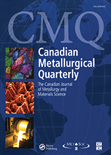
CANADIAN METALLURGICAL QUARTERLY
Shaping Tomorrow's Metallurgical Innovations Today.Canadian Metallurgical Quarterly is a prestigious scholarly journal published by Taylor & Francis Ltd, dedicated to the field of metallurgical engineering and materials science. With a rich history dating back to its inception in 1962 and continuing through its most recent publications, this journal serves as a vital platform for the dissemination of innovative research, advancements, and critical reviews in metallurgy, metals, and alloys. Positioned strategically within the academic community, it holds a significant impact factor and is currently rated in the Q2 category for Metals and Alloys, and Q3 in Industrial and Manufacturing Engineering as of 2023, showcasing its authoritative role in these disciplines. Although it does not offer open access, the journal remains widely recognized for its rigorous peer-review process, ensuring that published work adheres to the highest standards of scientific quality. Researchers, professionals, and students alike will find invaluable insights and contributions that drive the field forward.
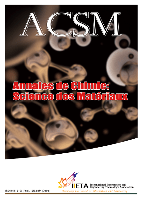
ANNALES DE CHIMIE-SCIENCE DES MATERIAUX
Advancing the Frontiers of Materials ChemistryANNALES DE CHIMIE-SCIENCE DES MATERIAUX, published by the International Information & Engineering Technology Association, serves as a significant resource in the field of materials chemistry. With an ISSN of 0151-9107 and an E-ISSN of 1958-5934, this journal has been contributing to the scientific discourse since its inception in 1947. The journal is classified in the Q3 category for Materials Chemistry in 2023, positioning it within the 29th percentile in the Scopus ranking for materials science, underscoring its commitment to advancing knowledge and innovation in this vital area of research. Although currently not an open access publication, the journal welcomes submissions that explore a broad range of topics related to material science, thereby facilitating discussions that can lead to groundbreaking discoveries. Researchers, professionals, and students are encouraged to engage with the journal to stay at the forefront of materials chemistry, especially given its historical context and ongoing relevance in academic and industrial applications.
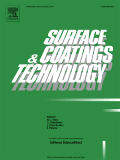
SURFACE & COATINGS TECHNOLOGY
Unveiling the Science Behind Surfaces and CoatingsSURFACE & COATINGS TECHNOLOGY is a premier academic journal that has been at the forefront of research and innovation since its inception in 1986, diligently published by Elsevier Science SA. With an impressive range of studies focusing on surface and coatings technologies, the journal has established itself as a leading platform within the fields of Chemistry, Condensed Matter Physics, and Materials Science. Notably, it holds a distinguished Q1 ranking in multiple categories, showcasing its relevance and high impact in the academic community. Furthermore, it is recognized for its rigorous peer-review process and is indexed in esteemed databases, maintaining its strong position with a ranking of #17 in Surfaces, Coatings, and Films. Although the journal does not currently offer open access options, it continues to be a crucial resource for researchers, professionals, and students seeking insights into cutting-edge developments and applications in the domain of surface engineering. With a commitment to advancing knowledge across these disciplines, SURFACE & COATINGS TECHNOLOGY is an essential read for anyone interested in the latest trends and technologies shaping the industry.

Journal of Coatings Technology and Research
Exploring the Science Behind Coatings ExcellenceThe Journal of Coatings Technology and Research, published by Springer, stands as a vital resource for researchers and professionals in the fields of materials science and chemistry. With an ISSN of 1547-0091 and an E-ISSN of 1935-3804, this journal is recognized for its significant contributions to the study of coatings technology, encompassing diverse aspects from surfaces and interfaces to colloids and surface chemistry. Currently holding a 2023 Impact Factor that places it in the Q2 and Q3 quartiles across several categories—including Chemistry and Colloid and Surface Chemistry—the journal serves as an essential platform for disseminating innovative research. Its accessibility options cater to a broad audience, ensuring that both established scholars and emerging researchers can engage with the latest findings. Since its inception in 2004, the journal has continued to foster advancements in coatings technologies, promoting sustainable practices and novel applications across industries.
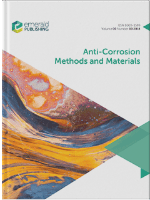
ANTI-CORROSION METHODS AND MATERIALS
Exploring Advanced Materials for Lasting ProtectionANTI-CORROSION METHODS AND MATERIALS, published by EMERALD GROUP PUBLISHING LTD, is a leading journal in the fields of chemical engineering and materials science, focusing on innovative methods and materials for corrosion prevention and control. With its ISSN 0003-5599 and E-ISSN 1758-4221, this esteemed journal has been contributing to the academic community since its inception in 1954 and continues to be relevant through 2024. Despite its Q3 ranking in both Chemical Engineering and Materials Science categories, the journal plays a critical role in disseminating valuable insights and advancements, catering to a diverse audience of researchers, professionals, and students. Although the journal does not offer open access options, it remains a significant resource for those seeking to enhance their understanding of corrosion methodologies and to implement best practices in various industrial applications. With the recent Scopus rankings reflecting its impact, ANTI-CORROSION METHODS AND MATERIALS stands as a pivotal element of scholarly discourse in mitigating corrosion challenges in modern materials.
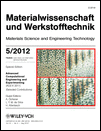
MATERIALWISSENSCHAFT UND WERKSTOFFTECHNIK
Empowering Engineers Through Material Insights.MATERIALWISSENSCHAFT UND WERKSTOFFTECHNIK, published by WILEY-V C H VERLAG GMBH, is a prominent journal dedicated to the field of materials science and engineering. With its ISSN 0933-5137 and E-ISSN 1521-4052, this journal serves as a vital resource for researchers and professionals engaged in exploring the intricate relationships between the properties of materials and their applications. Established in 1970 and continuing through 2024, the journal has been consistently recognized in various categories, achieving a Q3 ranking in 2023 across Condensed Matter Physics, Materials Science (miscellaneous), Mechanical Engineering, and Mechanics of Materials. Although it does not offer open access, its high-quality peer-reviewed content is fundamental to the advancement of knowledge within its three key areas: novel material development, material characterization, and application of materials in engineering contexts. As a driving force in the scientific community, MATERIALWISSENSCHAFT UND WERKSTOFFTECHNIK continues to cater to the curiosity of aspiring students, seasoned professionals, and researchers alike, facilitating a deeper understanding of the complexities of material technology.

China Surface Engineering
Shaping the future of surface technology.China Surface Engineering is a prominent academic journal dedicated to the field of materials science, with a specific emphasis on surfaces, coatings, and films. Published by the Chinese Association of Science and Technology (CAST), this journal serves as an essential platform for researchers, professionals, and students seeking to disseminate knowledge and advancements in surface engineering technologies and innovative applications. With its ISSN 1007-9289 and E-ISSN 1007-9289, it has established a distinct presence since its convergence in 2016, and continues to evolve in the rapidly advancing materials science landscape through to 2024. Although currently categorized in the Q4 quartile of its field, with a Scopus ranking of #103 out of 132 in Surfaces, Coatings and Films, the journal plays a critical role in contributing to the discourse surrounding surface treatment and modification, fostering advancements that are pivotal for industrial applications. As an avenue not only for knowledge transfer but also for collaboration among scientists worldwide, China Surface Engineering is crucial for anyone engaged in research or practical applications in this domain.

RUSSIAN JOURNAL OF ELECTROCHEMISTRY
Unveiling Innovations in Electrochemical ApplicationsThe Russian Journal of Electrochemistry, published by Pleiades Publishing Inc, is a reputable scientific resource that caters to the dynamic field of electrochemistry. Since its inception in 1996, this journal has become a platform for the dissemination of cutting-edge research, exploring both foundational studies and innovative applications within electrochemical science. Despite currently holding a Q4 categorization in its field, the journal is dedicated to enhancing its scholarly impact and visibility, reflecting its commitment to fostering advancements in electrochemical technologies. With its ISSN 1023-1935 and E-ISSN 1608-3342, the journal strives to reach a global audience of researchers, professionals, and students alike. Though the journal is not open access, its contents are crucial for anyone looking to stay at the forefront of electrochemical research and developments. The journal's editorial board includes well-respected experts, ensuring that published articles contribute significantly to the scientific community and pave the way for future innovations in the field.